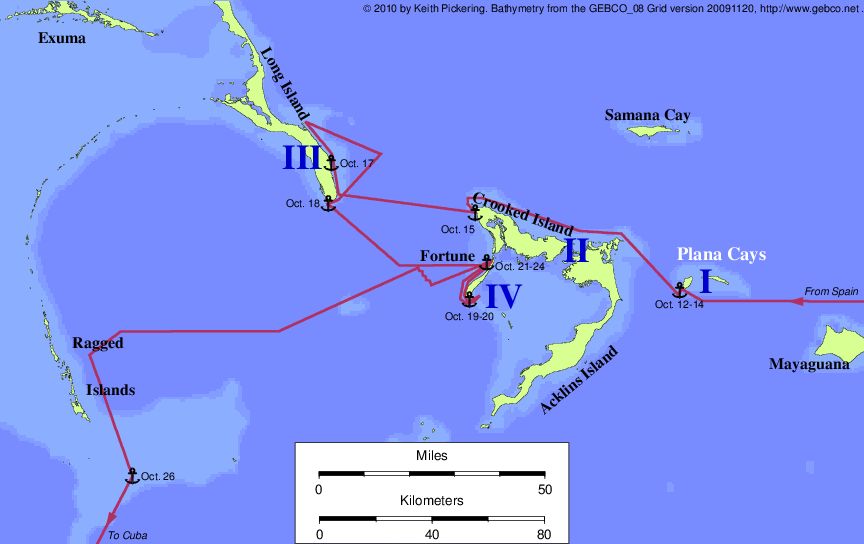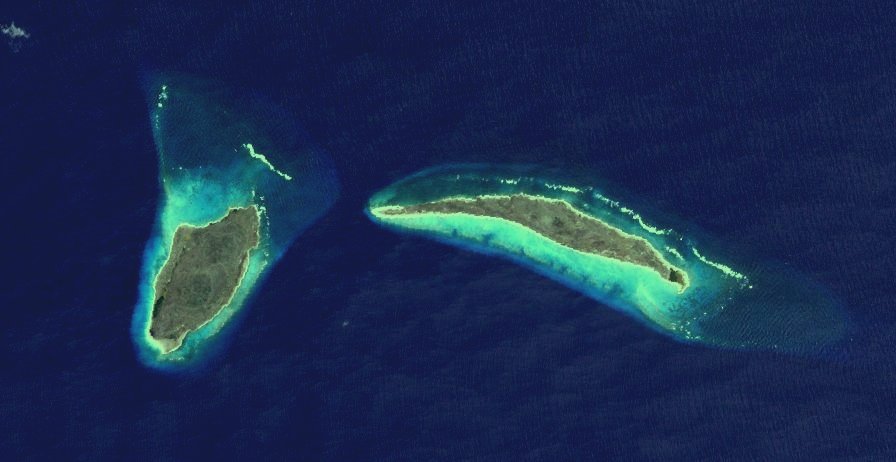Plana Cays Landfall (original) (raw)
The best theory: The Plana Cays

| Map of the Plana Cays route (Pickering 1994) | |
| ------------------------------------------------------------- | |
|  | |
| |
The Plana Cays theory was first proposed by Ramon J. Didiez Burgos in his book, Guanahaní y Mayaguain, which has been almost completely neglected since its publication in 1974. This may be in part due to its unwelcome thesis, or perhaps due to Didiez's almost impenetrable prose.
Didiez proposed that Mayaguana was the source of the light of October 11, and that the first landfall was at the western of the two Plana Cays. From that point, Didiez follows Varnhagen's route along the north coast of Acklins and Crooked (Island II), then circumnavigating Long Island (Island III). Fortune Island is Island IV.
The theory was revived twenty years later by Keith Pickering (yours truly) who substituted Fox's route along the east coast of Long Island for Didiez's impossible circumnavigation of Long. At the US Naval Institute debate on the landfall in April 1992, moderator William F. Buckley awarded a TKO to the Plana theory because of its perfect fit to the most important clue in the log: the north-south coast of Island II that faces Island I. This is the only place in the log where Columbus tells us the direction to Island I from any other point.
Pickering's article appeared in the history of science journal DIO. Click here to view the DIO article. Since that article was written, a few new wrinkles have been added. Models of the Earth's magnetic field in historical times have been improved, indicating a landfall in the central Bahamas (including Plana); see my lecture on the transatlantic track.
Also, the issue of seeing Island III from Island II, which had been a long bugaboo, has been resolved through another application of science. Every afternoon shortly before sunset there comes a point at which the outgoing infrared radiation from the Earth's surface becomes greater than the incoming solar radiation. When this happens convection in the troposphere shuts down, the Earth's surface begins to cool, and a nocturnal boundary layer (or NBL) begins to form. What is an NBL? The "usual" daytime situation for the atmosphere is that the air is warmest at the surface, and cools as you go up. That happens because the surface is absorbing heat from the sun, and getting rid of it by convection. But when the surface begins to cool, that situation is now reversed: the surface is now a cool sink instead of a heat source for the air, and the air right above the surface has a temperature inversion, meaning it's cooler as you go lower. The layer in which this temperature inversion is present is the nocturnal boundary layer.
That's important, because the standard equations that determine the maximum sighting distance are based on standard daytime conditions. But right before sunset, with a temperature inversion right at the surface of the sea, and with lines of sight to distant object skimming right though the NBL, atmospheric refraction is higher than standard. In other words, right at this time of day, you can actually see farther. (In fact, CC mentions this in the Diario, and nobody ever gave it much credence.) Since in the Plana theory, CC's fleet was rounding Bird Rock just at sunset, and since they were only just a mile beyond the distance needed for seeing Long Island under the standard equations, even a moderate temperature inversion would be enough to allow CC to see Long Island at that time of day. Which is a long way of saying, I have changed the scorecardon this clue and given Plana a 2 (up from zero) on this point. I've also updated Samana and Mayaguana, which share the same route at this point.
The Plana Cays is the most likely landfall, not because it's a perfect theory (there is no such thing in this debate) but simply because it has fewer and less serious problems than any of the others -- in some cases, a lot fewer.

Unresolved problems with the Plana theory:
- There are no references on old maps to Plana as Guanahani.
- The Plana Cays are two islands. Columbus does not specifically say that there are two islands in the log.
- Columbus described a large pond in the middle of Island I. The large ponds at Plana are not in the middle of the island.
- There was a peninsula with a narrow neck at Island I. There is no such peninsula at Plana.
- Acklins Island is marginally visible from the Plana anchorage. Columbus does not mention other visible islands until after leaving Island I.
- The coast of Island IV does not run west from the northern point.
- The coast of Island IV is not 12 leagues long.
And that's about it. The shortest list of the bunch.

| Landsat image of the Plana Cays | |
| ---------------------------------------------------------------- | |
|  | |
| |
The quote:
"If the Plana Cays were one island . . . it would absolutely be the landfall"
-- Joseph Judge, former National Geographic Senior Editor, in a letter to Keith Pickering, August 10, 1992
